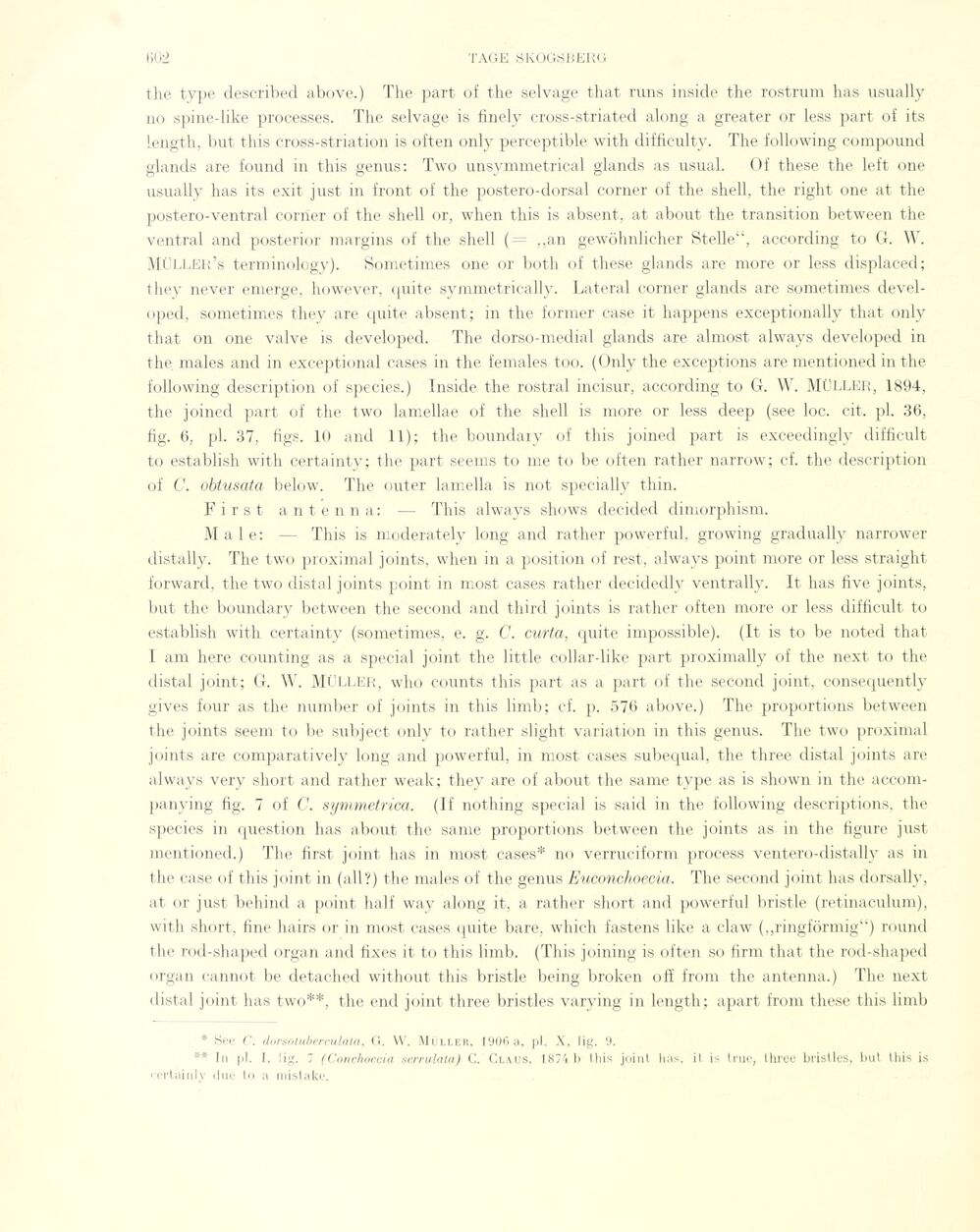
Full resolution (JPEG) - On this page / på denna sida - Sidor ...

<< prev. page << föreg. sida << >> nästa sida >> next page >>
Below is the raw OCR text
from the above scanned image.
Do you see an error? Proofread the page now!
Här nedan syns maskintolkade texten från faksimilbilden ovan.
Ser du något fel? Korrekturläs sidan nu!
This page has never been proofread. / Denna sida har aldrig korrekturlästs.
the type described above.) The part of the selvage that runs inside the rostrum has usually
no spine-like processes. The selvage is tinelv cross-striated along a greater or less part of its
length, but this cross-striation is often only perceptible with difficulty. The following compound
glands are found in this genus: Two unsymmetrical glands as usual. Of these the left one
usually has its exit just in front of the postero-dorsal corner of the shell, the right one at the
postero-ventral corner of the shell or, when this is absent, at about the transition between the
ventral and posterior margins of the shell ( - ,,an gewöhnlicher Stelle“, according to G. W.
MÜLLER’s terminology). Sometimes one or both of these glands are more or less displaced;
they never emerge, however, quite symmetrically. Lateral corner glands are sometimes
devel-oped, sometimes they are quite absent; in the former case it happens exceptionally that only
that on one valve is developed. The dorso-médial glands are almost always developed in
the males and in exceptional cases in the females too. (Only the exceptions are mentioned in the
following description of species.) Inside the rostral incisur, according to G. W. MÜLLER, 1894,
the joined part of the two lamellae of the shell is more or less deep (see loc. cit. pl. 36,
fig. 6, pl. 37, ligs. 10 and 11); the boundary of this joined part is exceedingly difficult
to establish with certa in ty; the part seems to me to be often rather narrow; cf. the description
of C. obtusata below. The outer lamella is not specially thin.
First antenna: — This always shows decided dimorphism.
Male: — This is moderately long and rather powerful, growing gradually narrower
distally. The two proximal joints, when in a position of rest, always point more or less straight
forward, the two distal joints point in most cases rather decidedly ventrally. It has live joints,
but the boundary between the second and third joints is rather often more or less difficult to
establish with certainty (sometimes, e. g. C. curta, quite impossible). (It is to be noted that
I am here counting as a special joint the little collar-like part proximally of the next to the
distal joint; G. W. MÜLLER, who counts this part as a part of the second joint, consequently
gives four as the number of joints in this limb; cf. p. 576 above.) The proportions between
the joints seem to be subject only to rather sliglit variation in this genus. The two proximal
joints are comparatively long and powerful, in most cases subequal, the three distal joints are
always very short and rather weak; they are of about the saine type as is shown in the
accom-panying fig. 7 of C. symmetrica. (If nothing special is said in the following descriptions, the
species in question lias about the same proportions between the joints as in the figure just
mentioned.) The first joint has in most cases* no verruciform process ventero-distally as in
the case of this joint in (ail?) the males of the genus Euconchoecia. The second joint lias dorsally,
at or just behind a point half way along it, a rather short and powerful bristle (retinaculum),
with short, fine hairs or in most cases quite bare, which fastens like a claw (,,ringförmig“) round
the rod-shaped organ and fixes it to this limb. (This joining is often so firm that the rod-shaped
organ cannot be detached without this bristle being broken off from the antenna.) The next
distal joint has two**, the end joint three bristles varying in length; apart from these this limb
* See C. dursotuberculata, G. W. Müller, 1906 a, pl. X, fig. 9.
** In pl. 1. lig. 7 (Conchoecia serrulala) C. Claus, 1874 b Ibis joint has, it is true, three bristles, but this is
■ ertainlv due to a rnistake.
<< prev. page << föreg. sida << >> nästa sida >> next page >>